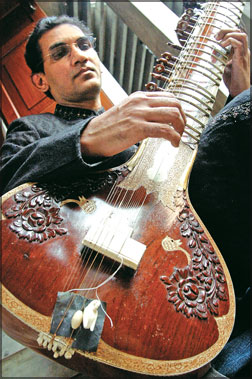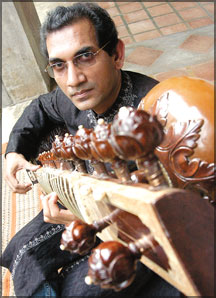Symphony of the Sitar
Music virtuoso Pradeep Ratnayake back in concert:
Aravinda HETTIARACHCHI
Pradeep Ratnayake is a sitarist whose
performances and compositions have drawn world wide acclaim.
A classically trained sitarist holding a
Master's Degree in Music from the University of Visva Bharati,
Santiniketan, India, he also composes fusing the major traditions of
music and the folk melodies of his country in his work. His most recent
work is the Kuveni Concerto for sitar, cello and orchestra premiered in
Germany with the Neubrandenburgh Philharmonic Orchestra in May, 2010.
Ratnayake is a Senior Lecturer in the Department of Languages and
Cultural Studies, University of Sri Jayawarednepura.
* Ravi Shankar's personality in Sitar has been uncovered around the
world. What is your Sitar's approach or tradition into a global
understanding?
|

Pradeep Ratnayake
Pictures
by Ruwan de Silva |
Ravi Shankar is my favorite Sitar player. In my childhood I imitated
him to a certain extent. When he visited this isle I had the opportunity
to perform in front him. He highly admired my playing and wanted to take
me to India to teach me more. But my father did not allow. Ravi Shankar
did his experiments of North Indian classical music but he was always
within the basic framework.
Later I had the chance to learn at Shanthi Niketan for over seven
years and completed my Master's in Sitar. I also learnt Sitar according
to a grarana system (named Maihar), a traditional lineage education of
'teacher-pupil' type, under Pandit Indranil Bhattachrya. My teacher
Indranil's father Timil Bharan was the first pupil of Ostad Al-Uddheen
Khan, the teacher of Ravi Shankar.
Universities in India do not follow the grarna framework. They only
follow the method introduced by Pandit Bhathkanda. But with all this
Indian traditional background, I thought of penetrating a new path of my
own identity in Sitar beyond the compact tradition of Indian classical
music.
I was very much influenced in western music since my childhood. I
started with the Hawaiian guitar under Patrick Rodrigo when I was five.
That is before I drew my soul into Sitar. I was unwrapped to the western
techniques in music too.
This gave my Sitar a capacity to intermingle with the western guitar
techniques.
For instance the staccato (scattering of sound) technique cannot be
seen in the North Indian classical music. This music always follows the
sound with a technique of an uninterrupted and continuously flowing
sruthi (macro-tones) named Meend.
In the 90s I searched for a unique mode to expose Sitar to the world
with a new dimension of my own. I have studied almost all Sitar players
and whether they have made up new things.
I found some refined ragas such as mand were thoroughly influenced by
Indian folk tunes though they are not that much classical and
traditional in spirit. This raga's flavor can also be seen even in
Lankan songs such as Sunil Santha's Mal Pibideegena Enne and Ananda
Samarakone's Siri Saru Sara Kethe. I noticed ragas are deeply connected
to the folk tunes in India.
 I therefore thought of using our Lankan folk tunes as the root of
most of my creations and composed them with the harmonies and chord
works of European music traditions: blues, jazz, rock and classical. I therefore thought of using our Lankan folk tunes as the root of
most of my creations and composed them with the harmonies and chord
works of European music traditions: blues, jazz, rock and classical.
I have used a lot of refined techniques in western music that are
never used in the traditional music before. And most of the people were
astonished how I blend the sound of beraya (Lankan drum) with the sound
of Sitar. In such a way I could twist the sound of sitar to a new path
of refined symphony.
* Sitar is an eastern music instrument. How have you unpacked your
Sitar to the western instrumentalists?
Music is a world language and it doesn't need any authorized national
language to express. We communicate through music notes. Sounds of these
notes are the same though named as different symbols in different
traditions.
If I can write my sound or tune correctly with the relevant symbols,
then any instrumentalist can join me even without knowing my mother
tongue.
In this connection the important thing is the particular note and its
nature.
I don't have to express the entire folk tune to the other. The
notation is more than enough. And the world today has a huge capacity to
experiment in music. It has reached the level of using computers to
refine Sitar or any other instrument. Pandit Ravi Shankar used a lot of
western techniques in music for his creations. Yet he always came out
with a sound rooted down to Indian soul. I too wanted to picture my
local sounds accurately whether I convey it through Piano or any other
western instrument.
Sometimes the creation's background is also very important. Two
months ago I performed with Australian Joe Chindamo the Jazz pianist. He
played a piece created out of Lankan folk tune Thuranga Wannama. Yet
within this folk tune he used his own way of Jazz style to perform it.
I do not stick myself only to our local folk tunes. Sometimes I have
directly used the jazz and blues techniques for my compositions. The
centric essence of the creation should not always be fulfilled by a
Lankan folk tune. It should always be decided by the basic nature of the
creation.
In such occasions I only think of how I can merge the other sound
with my Sitar sound. And you should intensely study it.
Then only it becomes a success.
* Western orchestral arrangements in music reached India and Sri
Lanka in the 20th Century. These arrangements, without a proper music
institution, were used here in the Army, Navy, Air Force, Police bands
and the classical music societies of the upper middle class. How do you,
as a Lankan, link yourself with western music in such an environment?
I made the Kuveni Asna symphony while I was learning under the
sponsorship of a Fulbright scholarship at the University of Colombia.
There I learned western composition as a subject under Professor Arthur
Kampela.
He taught me of orchestral arrangements. It took almost six months to
create Kuveni Asna. The university environment influenced me a lot in a
different way. I observed symphonies and was very much affected by their
techniques. Music, generally, cannot be learned through books.
You have to experience it. And in Colombia, you have plenty to
observe. We can study a lot on symphonic arrangements such as their
basic frameworks and the ways of conducting instrumentalists.
Most instrumentalists in Lanka are talented. But we don't have
training facilities. Many countries offer scholarships for higher
education, maintaining competitions in music.
The performers have the opportunity to compete others. Consequently
they always gain the knowledge to weigh good against bad.
Sri Lanka doesn't have competition. If I have four or five players in
Lanka, then I would do new creations to compete them. It is great if
some musicians from abroad visit us to train our people to bring up a
new institution of music. I have reached this standard because I started
when I was six.
My father Bandula Rathnayake made me hear all great musicians. My
first Sitar teacher D A Devage never forced me to play his kind of
music. He only showed the path to be a sitarist.
Ragas from New York
Music lovers in Colombo will get a rare chance of hearing two world
class musicians give a concert of Indian classical music when Pradeep
Ratnayake and Nitin Mitta perform at the Lionel Wendt Theatre on January
6 at 7 pm. Pradeep’s and Nitn’s collaboration on the sitar and tabla
began during Pradeep’s tenure as a Fulbright student at Colombia
University, New York, from 2008 – 2010. They have previously given
performances at Weill Recital Hall, Carnegie Hall, New York.
The concert, titled ‘Ragas from New York’, sponsored by the United
States – Sri Lanka Fulbright Commission and the American Centre,
Colombo, is the first of a two part series held to celebrate Pradeep
Ratnayake’s return to Sri Lanka after a two-year absence while he was a
Fulbrighter at Columbia. The second concert sponsored by HNB Assurance
will be held on January 22 at the Lionel Wendt and will feature his
innovative compositions played by some of the leading musicians in Sri
Lanka. In the first concert Pradeep will focus on classical music with
one of the best accompanists currently performing in the USA.
Nitin Mitta has a reputation as a tablist with a rare combination of
technical virtuosity, spontaneity, clarity of tone, and sensitivity to
melodic nuance. He is a highly sought after accompanist who has
performed with some of India’s most celebrated musicians, including
Pandit Jasraj, Pandits Rajan and Sajan Mishra, Pandit Vishwa Mohan
Bhatt, Ustad Nishat Khan and Ustad Shahid Parvez. Nitin has also made a
mark as a versatile collaborator in other spheres performing alongside
Jazz Pianist Vijay Iyer and Carnatic Electric Guitarist Prasanna in a
unique trio band named Tirtha. His work with Prasanna can be heard on
the soundtrack of the Oscar-winning documentary ‘Smile Pinki’. |



